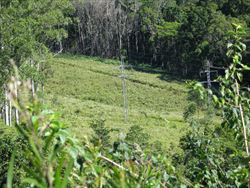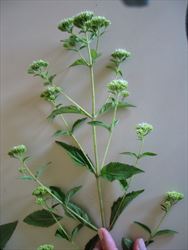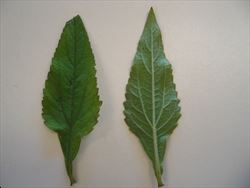Click on images to enlarge

infestation along powerline (photo: Andrew Ford)

branch (photo: Andrew Ford)

flower head (photo: Andrew Ford)

upper and lower leaf surfaces (photo: Andrew Ford)
Scientific Name
Stevia ovata Willd.Family
Asteraceae
Common Names
candyleaf
Origin
Tropical America, from Texas south to Mexico, Ecuador and Peru.
Naturalised Distribution
Currently restricted to a small area near Ravenshoe on the Atherton Tableland in north Queensland.
Habitat
Disturbed areas, open forest, native pastures and roadsides.
Habit
A straggling or erect perennial herb, sometimes shrub-like, with a large tap root.
Distinguishing Features
A perennial herb 40-80 cm high
Dense white clusters of flowers
Leaevs in opposite pairs along the stem but sometimes alternate
Leaves variable, mostly lance-shaped, 3-6 cm long and hairy.
Stems and Leaves
Stems are much branched with branches arising from leaf axils and opposite one another, occasionally alternating. Stems and leaves are green, hairy (pubescent) and minutely glandular when young. Leaves are on stalks (petioles) up to 1 cm long and vary in shape from ovate to lance-shaped. Leaves have raised veins beneath and serrated or toothed margins.
Flowers and Fruit
Flowers are small, white or pale pink daisy flowers that arise in clusters at the ends of the branches and often combine at the apex to form dense compoint umbel-like heads. The tubular flowers have five apical lobes and are minutely glandular. They are grouped into small clusters surrounded by glandular green bracts. The hard brown fruit (achenes) are narrow, longitundinally ridged and smooth (with a few minute hairs), with a small pappus (crown) of scales at the apex.
Reproduction and Dispersal
Seeds are dispersed by wind, water, machinery and animals. The longevity of seeds is unknown.
Environmental Impact
The environmental impact of Candyleaf is unknown, but it has been observed to form dense stands in disturbed, open areas.

